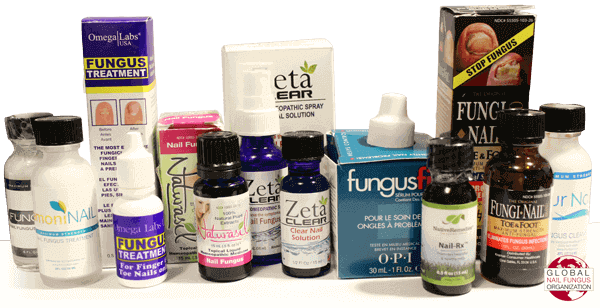Treatment Types:
Table of Contents
What Treatments are used for Fungal Nail Infections?
There are many treatments which are used to address fungal nail infections. They range from home remedies to surgical removal of the infected nails. Cost of treatment ranges from a few dollars to many thousands of dollars. Safety and effectiveness of treatments vary greatly.
Topical Treatments (over-the-counter)
A comprehensive list of OTC topical nail fungus treatments can be found on our medication comparison page.
The Best Topical Remedies for Fungal Nail Infections
Topical remedies which contain undecylenic acid and tea tree oil effectively treat nail infections. They are the most effective when combined into one topical product. The United States’ Food and Drug Administration, FDA, has approved the use of undecylenic acid as an effective agent for the treatment for fungal infections. It is a safe plant based remedy which is derived from castor oil. Tea tree oil has been the subject of extensive research studies which confirm its healing properties. The oil helps undecylenic acid penetrate deeply into tissues. Modern research proves that tea tree oil has antiseptic, anti-inflammatory, and antifungal properties. The oil relieves itchiness and promotes comfort.
Home Remedies
Herbal and homeopathic remedies have not been proven to be effective treatments for nail infections. More research is needed to evaluate their effectiveness. Home remedies have not been proven effective by the use of scientific analysis because limited research has been conducted about them. In general, if studies have been performed, they have been of poor quality and conducted on a very small number of individuals.
Some people have tried home remedies, such as bleach, peroxide, or vinegar to address their nail infections. These remedies are usually ineffective. In addition, they may weaken and irritate tender tissues. They are time consuming and may delay the implementation of treatment with more effective remedies. If you opt to use home remedies, here are some of the most common ones.
| Home Remedy for Fungal Infections of the Nails | Treatment Information |
| Vicks VapoRub | Apply daily to nails. According to the Mayo clinic, a study of eighteen people indicated that this treatment is sometimes effective. (Staff, 2014) |
| Bleach | Soak your hands or feet in a solution of one tablespoonful of bleach mixed with gallon of water twice daily for twenty minutes. Bleach kills microorganisms, however it can cause irritation and dryness of tissues. Be sure to rinse and dry the soaked hands or feet carefully after treatment. |
| Vinegar | Soak the affected area twice daily for twenty minutes in a solution made by mixing a 50:50 combination of vinegar and water. Rinse and dry the treated areas carefully after soaking. |
| Mouthwash | Soak the affected area in mouthwash for twenty minutes twice daily. This treatment may be expensive if several digits are affected. Irritation and dryness of the tissues may arise. Rinse and dry the treated areas carefully after soaking. |
| Hydrogen peroxide | Soak the affected area in a fifty percent solution of hydrogen peroxide and water for twenty minutes twice daily. Irritation and dryness of tissues may arise. Rinse and dry the treated areas carefully after soaking. |
Prescription (Rx) Treatments
Prescription Medications Used to Treat Fungal Nail Infections
Topical and internal prescription drugs may be used to relieve fungal infections. Whether you choose to use an over the counter or prescription remedy, be aware that it takes many months of treatment for a full resolution of the infection to occur, regardless which type of medication is used. If you opt to use prescription medications, be aware that they may take as long as one year to become fully effective. Many of the oral medications can cause serious, sometimes life threatening complications. Prescription topical remedies cause fewer side effects than oral ones, however, they may cause irritation or discomfort when applied. Topical prescription remedies may cost several hundred of dollars or more each month. (Source: GoodRX.com)
To view oral and topical prescription treatment options view our Medication Comparison page.
Surgical Treatment
Mechanical Treatment of Nail Infections
Health care providers may trim nails or surgically remove portions of badly infected nails. Sometimes an entire nail needs to be removed, and the tissues under it destroyed in order prevent a recurrence of infection. Debridement, which is the removal of the nail and tissues under, or surrounding the nails may be performed via mechanical or chemical means. Surgery and other mechanical treatments are performed in conjunction with oral or topical therapies.
Surgical Removal of a Nail
If a nail infection is severe, causes pain, and does not respond to other forms of treatment, surgery may be needed. All or part of the nail may be removed.
Here is how a nail is surgically removed .An anesthetic is injected into the affected finger or toe. The affected nail or area is surgically removed. A medication may be applied to the underlying tissues which destroys some of the tissues. This prevents the nail from re-growing. It is done in order to prevent future infection. An antibiotic is applied and the area is bandaged. Ongoing treatment with oral and topical antifungal agents is needed postoperatively. Risks associated with surgical removal of a nail include pain, infection, and disfiguration of the nail if it grows back. ( Healthwise staff, reviewers: Burgess,P and Thompson, E.G., 2014) If the surgery is performed on multiple toenails, crutches may be needed. The cost for surgical removal of a nail varies. The surgeon’s fee may be upwards of two hundred dollars. Anesthesia and the other medications may cost a thousand or more dollars. Depending upon where the procedure is performed, there may be a facility fee. Insurance may cover many of the costs of the procedure. (Ortiz)
Laser Treatment of Fungal Infections
Several small studies have been conducted to determine if the use of lasers may benefit individuals who have fungal infections of the nails. According to expert Ivan R. Bristow, more research is needed. He found that the studies were small in size. Among people who received laser treatments, no substantial benefits were obtained and reinfection appeared common. (Bristow, 2014).
The use of lasers is reserved for people who have severe fungal infections. Usually one treatment is sufficient. Costs range from two hundred to five hundred dollars for each affected nail. Depending upon the number of affected areas, severity of infection, costs of additional therapies and supplies, laser treatment may cost several thousand dollars. If more than one session is needed, the follow up treatments are generally one third of initial cost. Laser treatment of nail infections is considered to be cosmetic surgery so it is unlikely to be covered by health insurance. (Laser Treatment for Toenail Fungus, 2015)
Nonsurgical Nail Removal
Nonsurgical nail removal is a method for treating serious nail infections. A doctor removes all or part of an infected nail by debriding the affected area. Experts claim that the procedure is usually painless.
Here is how the procedure is performed. The skin surrounding the affected area is covered with a protective bandage. A nail dissolving ointment, which contains urea, is applied to the nail. The nail is enclosed in plastic and bandaged. The area stays covered for one week to ten days. This allows time for the nail to dissolve. At that time the entire nail or the affected portion is removed.
Medications are taken by mouth or applied topically for a period of time after the nail is removed. A fingernail grows back in six months, while a toenail may take a year or longer to regrow. By removing the nail or the affected portion of it, medication which treats the infection is able to be applied directly to the infected area. Risks of treatment include infection and the possibility that the fungus is not killed. ( Healthwise staff, reviewers: Burgess,P and Thompson, E.G., 2014)






